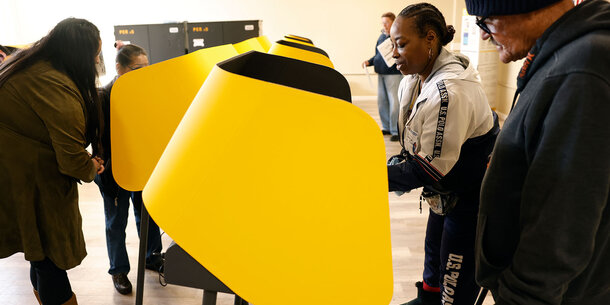During the early voting period in October 2022, some voters in Maricopa County, Arizona, arrived at a ballot drop box site to an unusual and unnerving scene: people armed with guns and dressed in tactical gear circling a 75-foot perimeter around the drop box. New state laws are urgently needed to stop occurrences like these, which are clear examples of voter intimidation.
The small but alarming group of Arizona vigilantes, some of them masked, showed up to surveil ballot drop boxes in the hopes of rooting out the same voter fraud that they falsely believe corrupted the 2020 election. Drop boxes — a safe and secure option for ballot collection that are often under official monitoring and surveillance — were cast as ripe for cheating based on unproven claims. Voters filed multiple complaints against the armed observers but law enforcement, who arrived after they left, determined that no state laws were broken since the civilians were outside a 75-foot perimeter, as required by Arizona law. One of the officers informed a remaining observer that wearing tactical gear could be intimidating and could be a violation of the law, according to body camera footage. A temporary restraining order granted by a federal court put more distance between armed civilians and the voting site only after an organization filed a lawsuit under the Voting Rights Act of 1965.
The incident in Arizona, part of the evolving election denier movement, reveals both the level of hostility in our elections post-2020, and how guns are intertwined in efforts to commit threats, harassment, and intimidation in and around voting. Currently, only 12 states and the District of Columbia prohibit both open and concealed carry of firearms at the polls. That’s according to Guns and Voting, a report released in September by the Brennan Center and Giffords Law Center.
The report identifies significant shortcomings in federal and state law for protecting voters and elections from gun violence. One of the biggest: neither federal nor any state law explicitly acknowledges that the presence of guns in or around places where people are voting and conducting elections can constitute illegal intimidation. The report also urges states to pass legislation to ban guns at sensitive locations, such as polling places.
So far this year, several states are considering bills to protect voters and election officials from the intimidating effect of guns at sites of voting and vote counting, including Massachusetts, Michigan, New Mexico, and Virginia.
Going a step further, California, a state that already bans both open and concealed carry at polling sites, is considering the Peace Act, a model policy proposed by the Brennan Center and Giffords in the report. It was introduced by Assemblymember Marc Berman (D) on Wednesday. The bill aims to prevent intimidation and violence in our elections, and it would cover instances similar to the scene in Arizona. The bill would replicate the Voting Rights Act’s prohibition on voter intimidation in state law and establish anti-intimidation protections for voters and election officials throughout the entire voting process. It would also explicitly presume that openly carrying a gun in and around a voting site is intimidating and strengthen other existing protections.
While it is already a crime to carry a gun at the polls in California, those prohibitions can only be enforced by state prosecutors who must meet exacting criminal legal standards because they aim to punish those who violate the law after the fact. The Peace Act would empower voters and election workers to pursue legal recourse themselves and, crucially, allow for prospective relief aimed at preventing intimidation in the future. And by inscribing the safeguards of federal law into California’s statutes, the bill would allow them to do so in state courts at a moment when federal courts have dramatically retreated from protecting voting rights. Further, by explicitly acknowledging the intimidating presence of guns in and around voting sites, the law essentially incorporates the state’s policy against firearms at the polls into anti–voter intimidation law, affirming the very real risk posed by the presence of guns to disrupt those exercising the franchise and the electoral system itself.
If enacted, this legislation would make a significant difference in California and potentially push other states to consider adopting it too. These reforms would ensure that every voter in the state has the strongest protections against intimidation and armed intimidation when they head to the polls this year. For example, in Arizona, if state law made clear that it is presumptively intimidating to openly carry firearms at polling sites, the observers may have been deterred from patrolling the drop boxes while armed. An explicit reference to guns in anti–voter intimidation law makes prohibitions on guns at polling places even more effective. In the Arizona situation, law enforcement officials would have had far more clarity in the law to protect voters’ rights over those intimidating them.
The Peace Act would push California to the forefront of protecting elections from intimidation and the risk of gun violence. The Voting Rights Act operates as a tool to shield voters from intimidation at the federal level, and with the Peace Act, voters, election officials, and law enforcement in the state would be empowered with an instrument to enforce the fundamental right to vote free of intimidation at the state-level.
California lawmakers should seize on this opportunity, other states should act as well.







